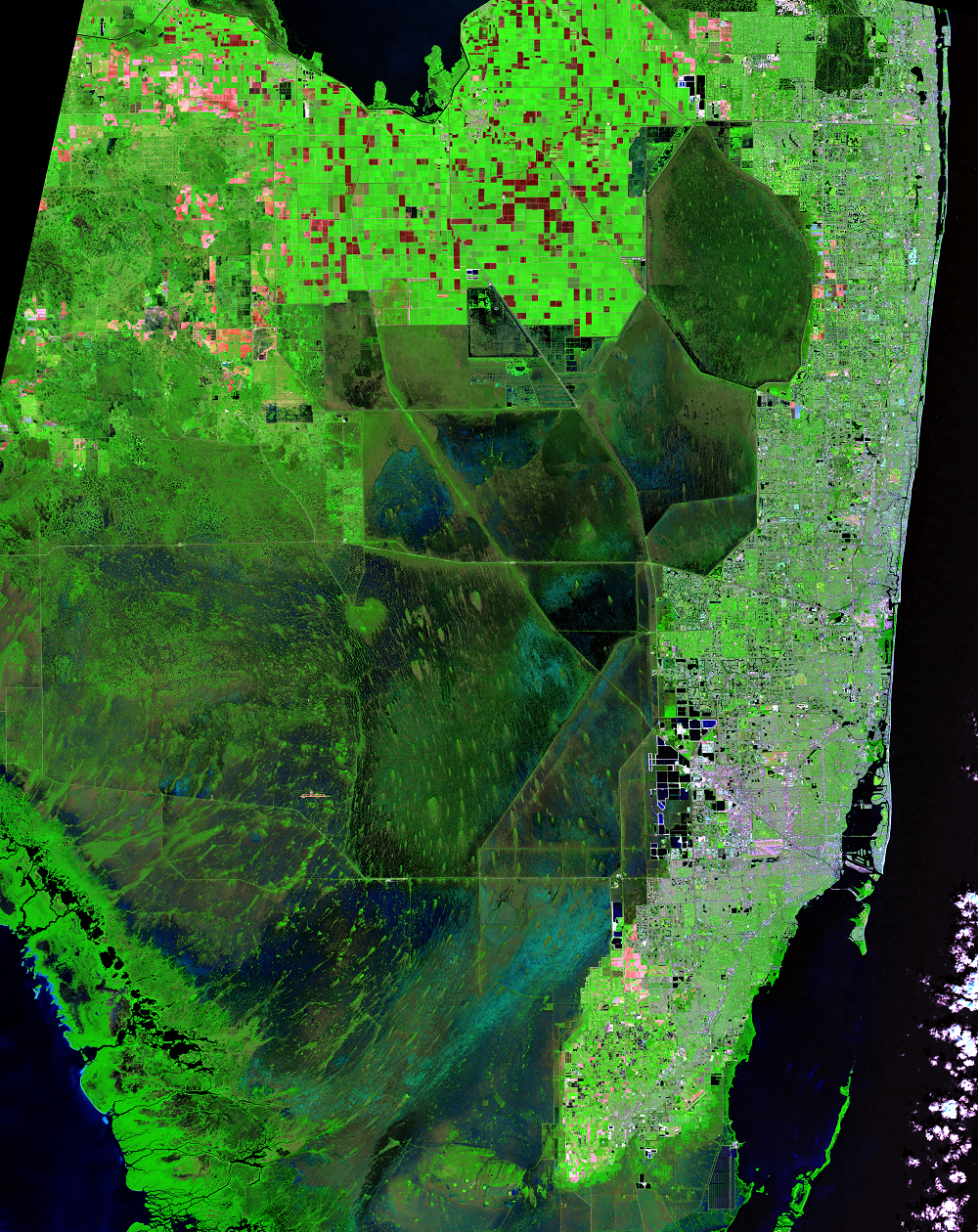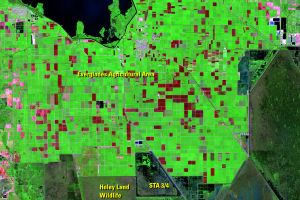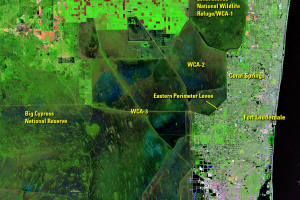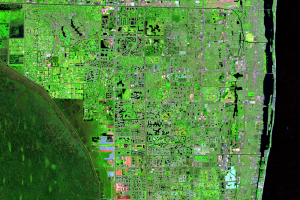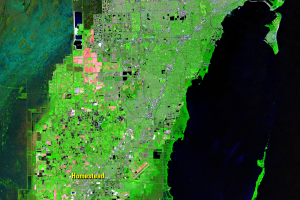
The Everglades and Miami, Florida, USA
Earth Resources Observation and Science (EROS) Center - Earthshots
Referred to as the “River of Grass,” the Florida Everglades is one of the world’s largest wetlands. However, they were once much larger. Throughout the 20th century, the region was drained for agriculture and development, and canals and levees were built to manage the water. The area that is protected as a national park, established in 1947, is a fraction of the original extent of the Everglades.
The Everglades is essentially a wide, slow-moving sheet of shallow water, hence the name River of Grass. The water originates at the Kissimmee River in central Florida, drains into Lake Okeechobee, then out into the Everglades. A rich variety of plant and animal habitats occupy this very flat terrain—even small water level changes significantly impact these communities.
Much of the development in the Everglades started long before the Space Age, but notable land changes occurred within the satellite era. This series of Landsat images shows the urban development of the Miami metropolitan area, agriculture, and the extent of land protections of southeastern Florida.
Imagery
Downloads
Everglades Restoration, [n.d.], So You Want to Know More About…USACE Lake Belt Permits: Comprehensive Everglades Restoration Plan (CERP), accessed March 29, 2016, at http://141.232.10.32/facts_info/sywtkma_lakebelt.aspx.
Florida Fish and Wildlife Conservation Commission, 2017, STA 3/4 Waterfowl SGA: State of Florida, accessed March 29, 2016, at http://myfwc.com/hunting/wma-brochures/s/sta-3-4/.
Florida International University, 2004, Ecosystems: South Florida Terrestrial Ecosystem Lab, accessed March 29, 2016, at http://softel.fiu.edu/index_files/page0008.htm.
Florida Power & Light Company, 2017, FPL taking action, protecting the future at Turkey Point: Florida Power & Light Company, accessed March 29, 2016, at https://www.fpl.com/landing/turkey-point-facts.html.
Hansen, K., 2016, Everglades National Park: NASA Earth Observatory, accessed March 29, 2016, at https://earthobservatory.nasa.gov/IOTD/view.php?id=89088.
Harvey, R.G., Loftus, W.F., Rehage, J.S., and Mazzotti, F.J., 2015, Effects of Canals and Levees on Everglades Ecosystems—Circular: University of Florida IFAS Extension, accessed March 29, 2016, at http://edis.ifas.ufl.edu/uw349.
Kambly, Steven, and Moreland, T.R., 2009, Land cover trends in the Southern Florida Coastal Plain: U.S. Geological Survey Scientific Investigations Report 2009–5054, 16 p.
Kindinger, J.G., 2002, Lake Belt Study area—High-resolution seismic-reflection survey, Miami-Dade County Florida: U.S. Geological Survey Open-File Report 2002-325.
Korzekwa, K., 2015, Bringing the Benefits of Tree Islands Back to the Everglades: Soil Horizons, v. 56, no. 6, accessed March 29, 2016, at https://dl.sciencesocieties.org/publications/sh/articles/56/6/sh2015-56-6-f.
National Park Service, [n.d.], Everglades National Park: National Park Service, accessed March 29, 2016, at https://www.nps.gov/ever/index.htm.
Nijman, J., and Clery, T., 2015, Rethinking Suburbia—A Case Study of Metropolitan Miami: Environment and Planning, v. 47, p. 69–88.
Renken, R.A., Dixon, Joann, Koehmstedt, John, Lietz, A.C., and others, 2005, Impact of Anthropogenic Development on Coastal Ground-Water Hydrology in Southeastern Florida, 1900-2000: Reston, Va., U.S. Geological Survey Circular 1275, 77 p.
Solecki, W.D., and Walker, R.T., 2001, Transformation of the South Florida Landscape, in Growing Populations, Changing Landscapes—Studies from India, China, and the United States: Washington, DC, National Academy Press, p. 237–273.
South Florida Water Management District (SFWMD), 2017, Lake Belt Mitigation Committee: SFWMD, accessed March 29, 2016, at https://www.sfwmd.gov/our-work/lake-belt-committee.
South Florida Water Management District (SFWMD), 2013, SFWMD Land Assessment, Fee-Simple Lands: SFWMD, accessed March 29, 2016, at https://www.sfwmd.gov/sites/default/files/documents/lass_portfolio_everglades_ecbuffer.pdf.
U.S. Census Bureau, 2016, Census of Population and Housing: U.S. Census Bureau, accessed March 29, 2016, at https://www.census.gov/prod/www/decennial.html.
U.S. Census Bureau, 2017, Metropolitan and Micropolitan Statistical Area Datasets: 2010-2016: U.S. Census Bureau, accessed March 29, 2016, at https://www.census.gov/data/tables/2016/demo/popest/total-metro-and-micro-statistical-areas.html.
U.S. Census Bureau, 2016, QuickFacts—Homestead city, Florida: U.S. Census Bureau, accessed March 29, 2016, at https://www.census.gov/quickfacts/table/PST045215/1232275.
Wetzel, P.R., Sah, J.P., and Ross, M.S., 2016, Tree islands—the bellwether of Everglades ecosystem function and restoration success: Restoration Ecology, accessed March 29, 2016, at http://onlinelibrary.wiley.com/doi/10.1111/rec.12428/full.

